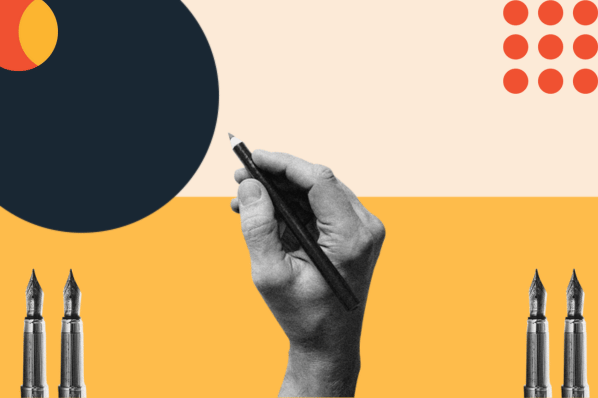What is design thinking?
Design thinking is a user-based approach to problem-solving that combines spontaneous, creative thinking with extensive, hands-on testing. It incorporates qualitative and quantitative research, as well as frequent ideation and prototyping, to reach innovative solutions to complex and difficult problems. While frequently applied to product and service development, design thinking can be used in any field that requires creative thinking.
Design thinking can be understood as both a philosophy of design and a series of design steps, with the former shaping the latter. First, let’s touch on the most important aspects of the design thinking philosophy:
Design thinking is user-centric. Above all else, design thinking solves for people. The interests of the company, historical trends, and even stakeholders come secondary to the people actually using the product or service. By focusing on the customers’ needs first and foremost, companies create human solutions that customers will enjoy, which in turn benefits everyone involved.
Design thinking is solutions-based. While we’ve called it a “problem-solving” approach, design thinking is less concerned with obsessing over challenges and more about finding solutions. Certainly, knowing your problem is important, but the bulk of the design thinking process is spent fixing it.
Design thinking is hands-on. If you want to try it, prepare to be active. From user research to idea generation to testing prototypes, every step of the process involves activities to make ideas tangible and testable.
Design thinking is iterative. Teams are expected to repeat activities, steps, and quite possibly the entire process until they’ve weeded out the bugs and found the best solution. Design thinking thrives on frequent experimentation, since you’re probably not going to get it right the first time.
Why is design thinking important?
As you may have realized by this point, design thinking is a highly involved and laborious process. Why go through all the effort? Here are some reasons why design thinking has gained so much traction across industries:
Design thinking makes us think differently.
After so much time spent … well, living, we’ve all developed our own ways of thinking and approaching problems. This is usually helpful, as we don’t have time to creatively address every little problem we face. Our minds are very good at identifying patterns in situations, then applying tried-and-true solutions to them.
However, this problem-solving mindset gets us stuck in one perspective. We may not be used to, or even be afraid of, breaking from our normal thought patterns and trying new things.
Design thinking remedies this by forcing us to adopt a different perspective and consider alternative ideas and strategies. It encourages us to reevaluate our preconceptions. Working against our brains is difficult, but ultimately leads to better innovation and a more impactful, perhaps less conventional final product.
In short, let’s think outside the box.
Design thinking helps us tackle big problems.
Some problems are straightforward — for example “Should I cook dinner or get takeout?” or “Where did I leave my wallet?” While I face these small problems on a regular basis, they’re common and therefore easy for me to understand and resolve.
But what about the problems that don’t fit into our everyday lives, or problems that are difficult to even define in the first place? What if you’ve received feedback from customers that your product design is poor or unintuitive? What if you’re struggling to break into a new market? What if you’re launching a food delivery app that needs to stand out from the big players? (Full disclosure: I’m a bit hungry writing this.)
Design thinking was made for these big problems, the ones without proven solutions that require creativity and introspection to unravel. The solution — and even the actual problem itself — might be far from what you expect.
Design thinking makes customers happier.
To keep us from getting carried away with our own interests, design thinking stays firmly user-centric. Every ideation session, experiment, and prototype is rooted in customer needs. By better understanding your audience, you’re more likely to serve a better user experience that people will actually want and recommend to others.
Design thinking is faster.
While it’s exciting to explore all the directions you can go with a project, that’s usually not realistic — you probably need definitive results within some time frame. Another advantage of design thinking is that it doesn’t stall around. Instead, it gets products to market quickly and thus saves organizations money.
As long as those involved are committed to the process, design thinking has been shown to yield large returns on investment compared to other strategies. This is because design thinking emphasizes solutions and rapid, repeated experimentation and keeps participants from fixating on challenges and limitations.
Anyone can use design thinking.
Design thinking is less “thinking for designers” and more “thinking like designers.” Though it first gained traction within the fields of design and engineering, design thinking has established a much broader appeal among businesses, nonprofits, academia, media and the arts, government organizations, and many other fields and industries that necessitate problem-solving. It’s by no means limited to designers — anyone can embrace the designer mindset to improve their product, service, business model, etc.
How is design thinking so adaptable? Again, we’ll circle back to prioritizing people. In the end, human problems require human solutions, something that major companies like IBM, Apple, and Bank of America have realized and embraced through design thinking. Your users hold the key, so find out what they need from you.
The Four Rules of Design Thinking
So far, we’ve learned the gist of the design thinking ideology and its benefits. Now, let’s see what actually makes up the design thinking process itself.
Many versions of the design thinking process have been developed, but they all follow the same general path. Here, we’ll cover the four rules and the five steps of the design thinking process formalized by Larry Leifer and Christoph Meinel at the influential Hasso Plattner Institute of Design at Stanford University, widely known as the d.school.
Let’s first start with the four rules that shape the process. These are:
The Human Rule
The human rule states that design is a social activity. In order to adopt a user-centric mindset, it’s best to collaborate in groups. This helps us challenge our preconceptions, think up more solutions, and stay grounded in the human side of design.
The Ambiguity Rule
The ambiguity rule of design thinking states that ambiguity is inevitable — you’re not going to have all of the answers, especially at the start. You can’t remove ambiguity either, so it’s best to embrace it by experimenting and exploring unknowns.
The Redesign Rule
According to the redesign rule, all design is redesign. While the circumstances surrounding our designs do change as we evolve socially and technologically, our core desires do not. Therefore, all designs are just ways to reach the same outcome in new contexts.
The Tangibility Rule
This last rule is more straightforward — the tangibility rule states that the best way to communicate ideas is through tangible things. While discussions, drawings, and walls of sticky notes can be useful, these are just a means to a physical prototype.
The Five Steps of Design Thinking
Next, let’s walk through the five stages of the design thinking process, starting at user research and simple experiments, and ending with testing your prototypes.
Note that, though I’m presenting these steps in a set linear order, the process itself isn’t so rigid. Design thinking is highly iterative and non-sequential: From start to finish, you’ll find yourself repeating steps and jumping back to previous steps as you encounter new obstacles and formulate better solutions. Steps can also occur simultaneously across different teams.
Applying some structure is valuable, though — it keeps projects on track and helps those without design experience adjust to the challenging process. So, let’s begin at step one.
1. Empathize with your users.
The first phase of any design thinking project is getting to know your audience. Once again, it’s all about the users, so start by identifying and understanding their wants, needs, challenges, and delightmoments.
To do this, gather feedback from your users through interviews, surveys, focus groups, and observation sessions. Watch users as they test your product, being careful not to inject your own thoughts into their experience. Expect users to behave differently than you assume — after all, you know the product better than anyone. Getting it wrong is okay (and expected), and learning how to correct based on feedback is a strength, not a weakness.
2. Define the problem.
The second step of a design thinking project is unpacking the results of your user research to uncover the main problem you’ll address. Highlight any standout feedback or recurring challenges your users encountered in your tests. Then, discuss with your team to find the root of these issues.
Again, put aside your assumptions in this phase of the project. The real problem may be different than what you expected and require ideas that diverge from what you’re comfortable doing. If you don’t have any clear takeaways, don’t guess about what users want — go back to the empathy phase and gather more data.
At the end of this phase, you’ll come up with a problem statement, a brief description that clearly defines the problem and guides your remaining work. Always frame your problem statement in terms of your customers’ interests to keep your designs user-focused. For example, “Our users need an easier, more intuitive way to order food through our delivery app.”
Notice how this design statement doesn’t specify how the problem should be solved, allowing for more creativity in solving it down the road. However, the end goal is still clear enough to pursue with confidence.
3. Ideate possible solutions.
At this phase, we move away from finding our problem and toward the meat of the process, solving our problem. The ideation phase is really just a fancy way of saying “brainstorm” — get as many ideas out in the open as you can without judgment, no matter how obvious or impractical they may be.
Facilitate ideation sessions through a variety of activities and games. For some ideas, check out our brainstorming recommendations. You can also try other creative exercises beyond brainstorming to extract even more solutions, and research other comparable products and services as inspiration for yours. Quantity is more important than quality in this phase, and the best activities are whichever get people thinking and sharing the most.
At the end of the ideation phase, you’re looking to take away a few ideas to bring to the next stage, prototyping.
4. Prototype your ideas.
The prototyping phase brings your ideas into the physical world. A prototype is a rough version of your idea used to test your solutions. The key word here is “rough” — these don’t have to be elegant, as long as they capture the essence of your idea. A prototype can take the form of a paper model, a 3D print of a product, or even a model with Lego bricks. For our delivery app, a slide deck can simulate the experience of navigating a user interface.
Developing prototypes will bring to light any immediate flaws in the idea without investing in a fleshed-out solution, so you can head back to the ideation phase if necessary. You may discover that a prototype works well with some minor tweaks, or it might be best to scrap completely. As long as you’re discovering these things and continuing to iterate, the process is working.
5. Test your product.
Once you’ve found success in one or more of your prototypes, the final stage in the process is scaling up to higher-fidelity designs and testing them on real users. In this phase, you can continue to refine your product based on observations and feedback from your audience.
Despite this being the final step, your design thinking probably won’t end here. It’s more likely that your testing will uncover some flaws in your prototypes, a shortcoming in your idea, or even a mischaracterization of the whole problem. Don’t get discouraged — again, this is to be expected. You should always return to a previous step and repeat it when warranted.
Does design thinking really work?
We’ve covered the benefits and the details of the design thinking process. Still, some of you may point out that I haven’t addressed the obvious question: Is it worth it? Does design thinking yield real results?
To be blunt, we wouldn’t be telling you about it if it didn’t. Design thinking is a widely acclaimed and proven approach to problem-solving at companies ranging from enterprises to startups, not to mention organizations in public health, education, philanthropy, and governance.
And, best of all, it doesn’t matter what field you’re in, what product or service you’re developing, whether you’re just starting your business, or if you’re well-rooted in your space — design thinking is as flexible as it is robust. It can be adopted by anyone to provide real value to the people who matter most, your customers.
So, start learning what your audience needs, then get creating. And, if you really are testing out a food delivery app and need participants, feel free to reach out to me.
.png?width=112&height=112&name=Image%20Hackathon%20%E2%80%93%20Square%20(10).png)
.jpeg)



![What's a Design System & What Components Is It Made Up of? [Examples]](https://53.fs1.hubspotusercontent-na1.net/hubfs/53/design-system.png)
.webp)


